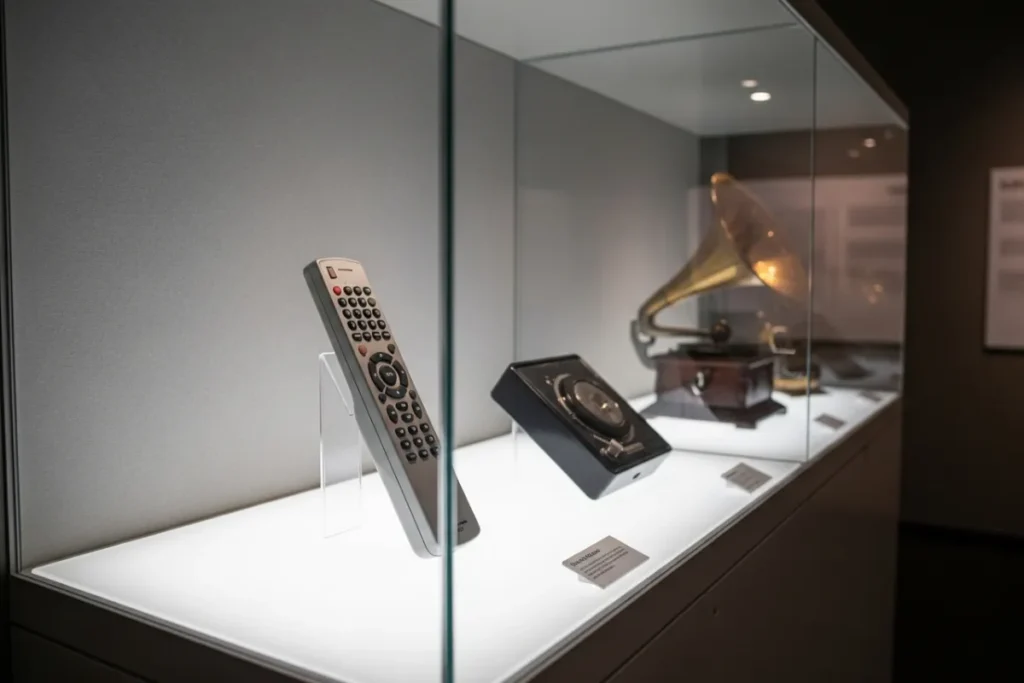Explore the transformative journey of remote controls from their inception to modern multifunctional devices in this comprehensive blog post. Delve into the psychological implications of remote control dependency, the technological advancements behind these gadgets, and the environmental concerns associated with their production and disposal. Discover how remote controls have not only reshaped our interaction with media but also fostered a passive entertainment culture, prompting a need to reassess our relationship with technology. Engage with insights on emerging alternatives and future trends that address both convenience and mindfulness in media consumption.
Table of Contents
Introduction to Remote Controls
The remote control invention represents a pivotal advancement in the way we interact with technology. Initially developed in the late 1950s, these devices have evolved significantly, moving from basic models to sophisticated gadgets that facilitate various applications beyond television. The first considerable device, developed by Robert Adler for Zenith, allowed users to replace the laborious task of getting up to adjust a television with the simple push of a button. This invention not only changed the dynamics of viewing experiences but also laid the groundwork for the passive entertainment culture that dominates modern media consumption.
As technology has progressed, so too have remote controls, incorporating newer functionalities that extend beyond traditional television usage. Modern remote controls often serve as multifunctional tools, capable of managing various devices in our homes including sound systems, gaming consoles, and home automation systems. This versatility emphasizes the significance of media control and society’s reliance on such gadgets for ease of access and comfort. Furthermore, the integration of touch screens, voice commands, and smart technology exemplifies the ongoing evolution in the history of gadgets that continues to redefine our interaction with media.
In recent years, the presence of screens in everyday life has fostered a concerning screen dependency behavior, where individuals often find themselves increasingly reliant on remote controls to navigate their entertainment options. As these devices grant users an unprecedented degree of control over their media consumption, they perpetuate a cycle that encourages sedentary lifestyles and diminished personal interactions. The remote control invention has undoubtedly transformed our experiences, but it also raises questions about its implications for well-being and social dynamics. Exploring these themes reveals how a seemingly simple device has reshaped our lives in profound ways.
The Convenience of Remote Controls
The invention of the remote control has significantly transformed our interaction with media devices, facilitating a more user-friendly experience. Initially introduced as a tool to minimize physical strain, the remote control has evolved to integrate seamlessly into our daily lives, bolstering the passive entertainment culture that dominates modern society. This convenience of controlling media from a distance enhances accessibility, allowing users to navigate channels, adjust volumes, and even switch devices effortlessly, all from the comfort of their seats.
This advancement in media control has also empowered users to multitask effectively. The ability to rapidly switch between different entertainment options fosters not only convenience but also an expectation for instant gratification in our screen-dependent behavior. With the proliferation of gadgets equipped with remote control functions, consumers are presented with an unprecedented level of autonomy. Whether controlling televisions, streaming devices, or home audio systems, the remote control serves as a crucial interface between users and their desired content, reflecting the broader implications of gadgetry in our lives.
As we consider the history of gadgets, it becomes clear that the remote control has played a pivotal role in shaping the way individuals engage with and consume media. The ease of use offered by these devices cannot be understated, as it caters to a diverse audience, making technology accessible to individuals of varying age groups and technical proficiency. In this sense, the remote control exemplifies a double-edged sword: it offers unparalleled convenience while simultaneously contributing to our reliance on passive entertainment and fostering an environment where media control has never been easier. As society navigates this balance, the significance of remote control invention continues to shape our interactions with technology.

Psychological Impacts of Remote Controls
The advent of the remote control invention has significantly altered our interaction with media and entertainment. This technological advancement offers convenience, allowing users to access a myriad of channels and content without the need to physically change settings. However, the ease of media control has nurtured a passive entertainment culture that can lead to various psychological implications. The immediate gratification afforded by a remote control fosters a desire for instant results, which can undermine our capacity for patience and critical thinking.
One of the most prevalent psychological effects is the development of dependency on these devices. People come to rely on remote controls not only for convenience but also as a crutch to navigate their viewing experiences. This dependency on remote controls can contribute to a concerning pattern of screen dependency behavior, where individuals find themselves disengaged from reality and overly absorbed in entertainment. The psychological impact of such behavior can manifest as reduced attention spans, diminished social interactions, and even feelings of isolation.
This phenomenon creates a false sense of freedom and autonomy, as individuals are led to believe they have complete control over their entertainment choices. In reality, this control can be an illusion, accentuated by pre-selected options provided by various media platforms. The history of gadgets has shown that innovations, while offering enhanced user experience, can also manipulate behavioral patterns. For instance, the increased accessibility to entertainment content can sometimes lead to a cycle of consumption—viewers feel compelled to watch “just one more episode,” ultimately sacrificing genuine engagement with more meaningful activities. Recognizing these effects is essential in fostering a balanced approach toward media consumption, prompting individuals to reassess their relationship with remote controls and reconsider the implications on their daily lives.
The Technology Behind Remote Controls
The evolution of remote control invention has drastically transformed how we interact with our entertainment systems. At the heart of remote controls lies a variety of technologies, each contributing to the seamless experience of media control. The most traditional technology utilized is infrared (IR), which operates by sending signals transmitted as infrared light. The remote emits this light, modulating information based on the command selected. The entertainment device, typically a television, has an IR receiver that interprets these signals, allowing users to navigate channels and settings without the need for physical contact.
Over time, advancements in technology have introduced alternative methods of communication, such as radio frequency (RF) and, more recently, Bluetooth. RF remote controls function via radio waves, enabling a broader range of control without the requirement for direct line of sight, a limitation seen in IR systems. This capability allows for greater flexibility, as users can operate devices from farther distances or even behind obstacles. Moreover, the introduction of Bluetooth technology has redefined media control by enabling two-way communication. This leads to more robust interactions between devices, facilitating functions beyond mere channel surfing, including browsing the internet or streaming audio.
As a focal point of modern entertainment systems, these technologies reflect a shift towards a more integrated passive entertainment culture. The ease of accessing myriad content instantly has fostered a screen dependency behavior that shapes societal engagement with technology. Over time, the history of gadgets like remote controls illustrates how they not only enhance user experience but also reflect broader trends in communication and accessibility. This ongoing advancement in remote controls underscores their crucial role in our daily consumption of media and present a clear example of how technological innovations cater to our evolving demands in managing entertainment effectively.

The Downsides of Remote Control Dependency
The advent of the remote control invention revolutionized the way we interact with media, allowing for unprecedented convenience and ease of access. However, this convenience comes with significant downsides that can adversely affect our physical and social well-being. One of the primary concerns is the contribution of remote control dependency to a sedentary lifestyle. As individuals increasingly rely on remote controls to navigate their media consumption, there is a marked decline in physical activity. The ease of remaining on the couch to switch channels or adjust volume results in fewer opportunities for movement, fostering an atmosphere where screens dominate our leisure time.
This behavior is exacerbated by the passive entertainment culture that has emerged alongside the proliferation of gadgets. Audiences are drawn into a cycle of consumption that often prioritizes quantity over quality, leading to extended periods of inactivity. The consequences of screen dependency behavior extend beyond physical health; they ripple through social interactions as well. Families and friends who once gathered for activities may instead find themselves isolated, each engrossed in their individual screens. Social communication and bonding are sacrificed, further promoting feelings of loneliness and disconnection.
Mental health implications also arise from this dependency on media control via gadgets. Studies have suggested that extensive screen time can lead to increased feelings of anxiety and depression. The expectation of constant media availability reinforces a sense of urgency that can disrupt healthy emotional regulation. Furthermore, the over-reliance on screen-based forms of entertainment detracts from the development of essential coping mechanisms needed in everyday life. The ramifications of these combined factors highlight that while remote control gadgets afford us a semblance of control over our media consumption, they may inadvertently limit our freedom in more profound ways. Dependency on these devices illustrates a paradox in society: what seems like liberation can also constrict our engagement with the world around us.
Environmental Considerations
The remote control invention has undoubtedly transformed the way we interact with our media devices, providing a level of convenience that reflects our passive entertainment culture. However, this technological advancement does not come without significant environmental considerations. The production and disposal of remote controls raise critical concerns regarding sustainability and the footprint associated with their manufacturing processes.
Manufacturing remote controls requires a variety of resources, including plastics, metals, and electronic components. The extraction and processing of these materials often result in considerable environmental degradation, including habitat destruction and increased greenhouse gas emissions. Furthermore, the process of assembling these gadgets contributes to energy consumption and pollution. As remote controls continue to be an integral part of our media control and society, it becomes important to recognize the environmental costs tied to their production.
Another critical aspect of environmental impact is the lifecycle of remote controls post-consumption. Many consumers may not consider the ramifications of disposing of these gadgets, which usually end up in landfills, contributing to the growing issue of electronic waste. The components contained within remote controls can be hazardous to the environment, as they may leach toxic substances into the soil and groundwater. Thus, the phenomenon of screen dependency behavior not only affects human interaction with technology but also has lasting impacts on ecological health.
As the history of gadgets demonstrates, the convenience introduced by remote controls fosters a reliance on technology that has far-reaching implications. Addressing the sustainability issues related to remote controls necessitates a shift toward more eco-friendly materials in manufacturing, as well as a more responsible approach to disposal and recycling. Promoting awareness of these environmental consequences is crucial for mitigating their overall impact on our planet.

The Future of Remote Controls
The evolution of remote control technology is poised for significant advancements, reflecting broader trends in smart home devices and artificial intelligence (AI). As society increasingly embraces the concept of passive entertainment culture, innovations in remote control systems are expected to enhance user experiences while transforming the media control landscape.
Smart home devices have already started to integrate seamlessly into daily life, allowing users to control various aspects of their environments with unprecedented ease. The potential future advancements in remote control invention may shift from traditional handheld devices to integrated systems, enabling users to manage everything from lighting to entertainment systems through a singular interface. These developments could fundamentally alter how we interact with technology in our homes, fostering a sense of control that extends beyond just media consumption.
Voice activation technology is another area where remote controls are likely to evolve. As smart assistants become more prevalent, the ability to control devices verbally eliminates the need for physical interaction. This represents not only a shift in the functionality of remotes but also suggests a deeper societal change regarding screen dependency behavior—where users may rely increasingly on voice commands as opposed to buttons. The integration of AI will further enrich this interaction, potentially allowing the system to learn user preferences and anticipate needs, enhancing the overall media control experience.
However, it is important to remain cautious about the implications of these developments. As we look towards the future, the potential for increased convenience must be balanced against the risks of further entrenching screen dependency behavior. The remote control, long considered a symbol of freedom in our media consumption, may evolve into a complex tool that reinforces our relationship with technology. Emerging trends in the industry beckon us to reflect on not just the history of gadgets, but also on how our growing dependence on these devices shapes society at large.
Alternatives to Traditional Remote Controls
As technology progresses, the traditional remote control invention is facing numerous alternatives that redefine how we interact with our media devices. The advent of mobile applications has emerged as a prominent method for controlling televisions, streaming services, and other electronic devices. These apps, often available for smartphones and tablets, allow users to operate their gadgets from virtually anywhere within network range. As a result, they facilitate a more dynamic engagement with media control, while aligning with the rising trends in passive entertainment culture. With customizable interfaces and the integration of smart home devices, mobile applications are transforming the ways in which we consume content.
Another innovative alternative includes gesture control technology, which allows users to operate devices through physical movements. Utilizing sensors and cameras, gesture control can recognize hand movements, enabling seamless navigation through menus and content. This form of interaction promotes an engaging experience in contrast to traditional remote controls. By doing so, it encourages active participation in our viewing habits and reduces screen dependency behavior, which has been a growing concern in media control and society.
Voice command technology also represents a significant shift in how we engage with our gadgets. Platforms such as Amazon’s Alexa, Google Assistant, and Apple’s Siri have made it possible to control devices through voice prompts. This advancement allows for hands-free operation, which is particularly advantageous for multitasking individuals. The convenience of voice command not only simplifies media interactions but also minimizes reliance on physical remotes, highlighting society’s transition towards more integrated and advanced forms of technology. As these alternatives gain traction, they suggest a shift away from traditional remote controls and their physical limitations, ultimately fostering a more accessible and interactive approach to our entertainment experiences.
Conclusion: Rethinking Our Relationship with Remote Controls
The remote control invention has dramatically transformed the way we interact with various media platforms, fundamentally altering the landscape of entertainment. As we have explored throughout this blog post, the evolution of gadgets designed for media control has given rise to a passive entertainment culture, wherein viewers often engage with content mindlessly. This cultural shift raises important questions about our screen dependency behavior and the implications it has for society at large.
As we continue to integrate advanced remote technologies into our daily lives, it is vital to consider the role of such devices in shaping our experiences. While remote controls provide convenience and accessibility, they also encourage a tendency towards disengagement from our surroundings and from meaningful interactions. The history of gadgets highlights a broader trend in which technological advancements, while beneficial in many ways, can inadvertently promote habits that contribute to a disconnected lifestyle.
Thus, it becomes essential for individuals to rethink their relationship with remote controls and the devices they influence. Emphasizing a balanced approach to technology use can foster healthier media consumption patterns. By being more intentional about how we engage with screens and the content we choose, we can mitigate the adverse effects of screen dependency and cultivate a more active relationship with entertainment. Ultimately, raising awareness about the implications of media control and its impact on society is crucial. By striving for a balance between convenience and mindfulness, we can reclaim a sense of control over our media consumption and ensure that technology serves to enrich our lives rather than detract from them.








